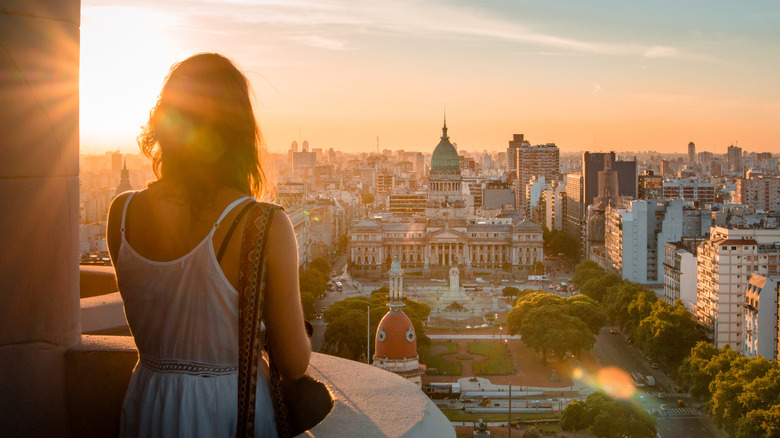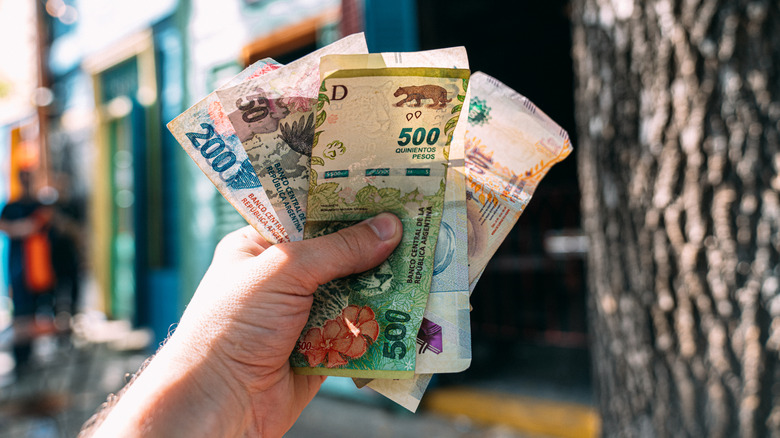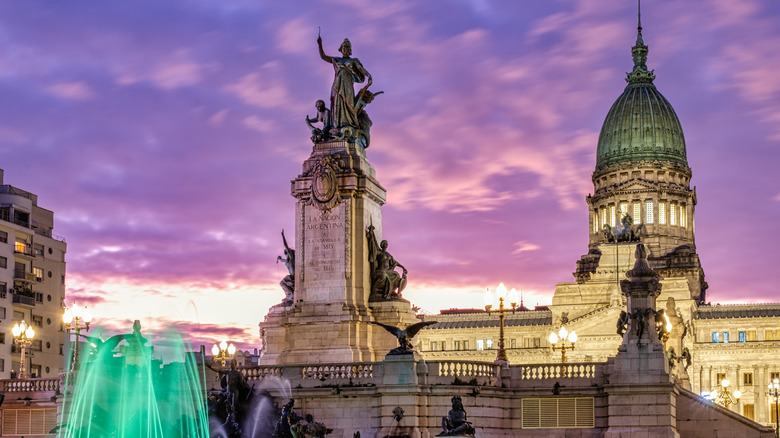The Tourist-Friendly South American Country Where The US Dollar Goes Far
As global exchange rates shift, one South American nation has emerged as a dream destination for budget-conscious travelers. While Thailand, Mexico, and even Japan have been known as low-cost destinations, for travelers seeking exceptional value, Argentina — that diverse range of land making up the bulk of South America's bottom half — stands out for stretching the American dollar further than many other countries on the continent. Both shoestring travelers and luxury connoisseurs can enjoy first-class experiences at a fraction of the usual cost while exploring a country rich in natural beauty, culture, and hospitality. Argentina's also one of South America's safest countries, known for its vibrant residents whose welcoming energy and infectious passions makes visitors feel at home.
As of this writing, one U.S. dollar (USD) is worth about 1,400 Argentine pesos (ARD). Since the late 1980s, Argentina has faced one of the highest global inflation rates in modern times, occasionally exceeding 100% and in 2023, hitting an all-time high, reaching more than 200%. This long-term currency depreciation has made the country exceptionally affordable for foreign visitors (though the downside is that it has been damaging for locals). Following new policies and lifted restrictions under President Milei in 2024, the peso again fluctuated, but by late 2025 there were signs of modest easing — though inflation remains high.
Officially, the Argentine government has a floating exchange rate within a fixed band, and for years, the official rate hasn't kept pace with high inflation, spurring an unofficial black market or "dollar blue," also known as "blue market" — often bought and sold on the streets or in informal exchange houses. Recently, major foreign credit cards, especially Visa and Mastercard, have begun converting purchases at the MEP rate, a stronger, market-based rate that closely tracks the blue dollar.
How to make your dollars go far in Argentina
In Argentina, frequent rate changes make costs unpredictable — Travel blogger Sol Solute notes that her "medialuna index" jumped from one peso for the iconic Argentine pastry in 2010 to 1,000 to 2,000 pesos in 2025. Still, travelers can expect excellent value on many things: a café con leche with an empanada might cost around $3.50 in Buenos Aires, one-bedroom Airbnbs might range from $50 to $100 per night, and a mid-range steak dinner might cost around $30 to $40. Public transportation is affordable, at about 50 cents per metro ride. Prices peak during the southern hemisphere's summer (December to February), so visiting outside those months can further stretch your budget.
Because Argentina has multiple exchange rates, knowing how to pay is crucial. Since 2024, Visa and Mastercard have adopted MEP rates closest to the blue-dollar rates, so credit cards are now one of the easiest ways to access a favorable rate. When prompted to choose pesos or dollars on a transaction, foreigners should select pesos, which yields the strongest rate. Cash is still useful for small purchases, and some restaurants and businesses offer cash discounts. But while blue-market moneychangers still exist, primarily along Calle Florida and in small "cuevas" — the unofficial money exchange offices — it's best to exercise caution when using them. The safest way to obtain cash is through Western Union's app, where you can wire yourself money and pick it up in local currency at any Western Union office (Buenos Aires has many). Because you'll receive large amounts of pesos at once, it's recommended to exchange no more than $200 or $250 at a time. In remote areas, plan to use cash primarily. Avoid ATMs in Argentina as the fees are high and withdrawal limits small.
Best affordable things to do in Argentina
Most travelers to Argentina start in its capital, Buenos Aires, affectionately nicknamed "the Europe of South America" for its old continent-influenced architecture. Sometimes overshadowed by other international destinations like Japan, Greece, or Italy, Buenos Aires is a magnificent city — the birthplace of tango, Lionel Messi, and some of the world's best steakhouses, like Parilla Don Julio, which has one Michelin star. This restaurant consistently ranks on top of global lists, and although prices have admittedly increased post-pandemic, it still costs less than many comparable award-winning restaurants abroad. If you can't snag a reservation, the city is full of excellent alternatives. Try El Desnivel in San Telmo, a favorite for affordable barbecue, or El Pobre Luis, a beloved neighborhood staple.
Even without relying on the favorable exchange rate, Buenos Aires is rich with free and low-cost activities. Wander through outdoor markets, sprawling parks, and museums, or join free walking tours where you can learn history from locals. Sip coffee at the historic Art Deco Cafe Tortoni, the oldest cafe in Buenos Aires, or buy a mate gourd and bombilla on Calle Florida, grab some yerba mate at a supermarket, and head to Plaza Francia for some leisurely people-watching.
But Argentina's far more than its capital. Mendoza, Argentina's acclaimed yet still underrated wine country and the birthplace of Malbec, is nestled at the foot of the Andes mountains, and offers tastings and vineyard experiences at a fraction of the price of places like Napa. Far to the south, Patagonia delivers some of the country's most stunning landscapes, from forested hikes to turquoise lakes. Whether you're exploring the icy beauty of Laguna San Rafael with its dramatic glacial views or birdwatching in the Iberá Wetlands, the region offers irreplaceable adventure at remarkable value.


